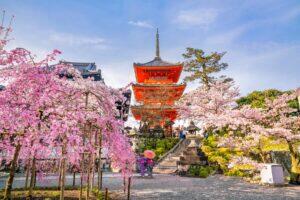Fodor's Expert Review Nanzen-ji Temple
Several magnificent temples share this corner of the forested foothills between Heian Jingu and Ginkaku-ji, but with its historic gatehouse the most prominent is Nanzen-ji. A short distance away are Nanzen-in, a subtemple noted for its garden's serene beauty, and Kochi-in, a subtemple, which also has a noteworthy garden.
As happened with Ginkaku-ji, the villa of Nanzen-ji was turned into a temple upon the death of its owner, Emperor Kameyama (1249–1305). By the 14th century this had become the most powerful Zen temple in Japan, which spurred the Tendai monks to destroy it. During the 15th-century Onin Civil War the buildings were again demolished. Some were reconstructed during the 16th century.
Nanzen-ji has again become one of Kyoto's most important Rinzai Zen temple complexes, and monks are still trained here. Entrance is through the enormous 1628 Sanmon (Triple Gate), the classic "gateless" gate of Zen Buddhism that symbolizes entrance into the most sacred part of... READ MORE
Several magnificent temples share this corner of the forested foothills between Heian Jingu and Ginkaku-ji, but with its historic gatehouse the most prominent is Nanzen-ji. A short distance away are Nanzen-in, a subtemple noted for its garden's serene beauty, and Kochi-in, a subtemple, which also has a noteworthy garden.
As happened with Ginkaku-ji, the villa of Nanzen-ji was turned into a temple upon the death of its owner, Emperor Kameyama (1249–1305). By the 14th century this had become the most powerful Zen temple in Japan, which spurred the Tendai monks to destroy it. During the 15th-century Onin Civil War the buildings were again demolished. Some were reconstructed during the 16th century.
Nanzen-ji has again become one of Kyoto's most important Rinzai Zen temple complexes, and monks are still trained here. Entrance is through the enormous 1628 Sanmon (Triple Gate), the classic "gateless" gate of Zen Buddhism that symbolizes entrance into the most sacred part of the temple precincts. After ascending, visitors have a view of the city beyond and the statue of Goemon Ishikawa. In 1594 this Robin Hood–style outlaw tried but failed to kill the daimyo (feudal lord) Toyotomi Hideyoshi. He hid in this gate until his capture, after which he was boiled to death in a cauldron of oil, thus lending his name to the old traditional rounded iron bathtubs once popular in Japan. His story is still enacted in many Kabuki plays.
On your way to see the major subtemples and gardens within the complex, don't overlook Nanzen-ji's other attractions. The Hojo (Abbots' Quarters) is a National Treasure. Inside, screens with impressive 16th-century paintings divide the chambers. Eitoku Kano (1543–90) painted these wall panels of the Twenty-Four Paragons of Filial Piety and Hermits. Outside, Enshu Kobori (1579–1647) is responsible for what's commonly known as the Leaping Tiger Garden, an excellent example of a dry rock-and-sand garden. The large rocks are grouped with clipped azaleas, maples, pines, and moss, all positioned against a plain white well behind the raked gravel expanse. The greenery effectively connects the garden with the lush forested hillside beyond. Visible in the complex's southeastern section is an arched redbrick aqueduct from the 1890s, with the waters of Lake Biwa, in the next prefecture, still flowing along it. The canopy of trees here, which keeps this favorite picture-taking spot cool, stands as a reminder of the city's awakening to new technology that changed residents' lives. Boring through the mountain allowed supplies as well as water to flow more easily into the city.
Nanzen-in 南禅院. This sub temples' east-facing garden has recently been renovated into a contemplative one with a pathway of diamond-shaped stones resting on moss-covered ground. Farther back is a large stroll garden with bridges over the tree-shaded, koi-stocked pond. A small building back here with a curving Chinese-style roof is a memorial to Emperor Kameyama.
Konchi-in 金地院. Recognized by aficionados around the world as one of Japan's finest gardens, Konchi-in was first established in the 15th century. It was moved inside Nanzen-ji's temple complex in 1605 and landscaped by designer Enshu Kobori several decades later. The elaborate black-lacquered gate, reminiscent of Nikko, is a shrine dedicated to Tokugawa Ieyasu, the shogun whose clan ruled Japan for centuries. The garden is one of Japan's finest examples of a classic tortoise-and-crane design, representing longevity and wisdom. It's also the most authentic example of Kobori's work. Konchi-in is before Nanzen-ji's main entrance, slightly southwest of the Sanmon Gate.
READ LESS







